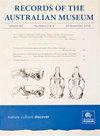澳大利亚东部深渊神秘螺属一新种(环节动物纲:蛇科)
IF 0.8
4区 生物学
Q4 ZOOLOGY
引用次数: 0
摘要
2017年5月至6月,RV Investigator号上的一支探险队对澳大利亚东部边缘从塔斯马尼亚岛中部到珊瑚海的较低斜坡和深渊沿线的底栖生物群落进行了采样。在这次航行中收集到的200多只蛇科环节动物被收集并存放在悉尼的澳大利亚博物馆。其中有一个鲜为人知的深海(3754–4378米)螺属的新种。Serpulids通常建造连接在坚硬基底上的圆柱形钙质管。到目前为止,据报道,深海中只有三种栖息在自由躺着的多角形管中的细尾蛇:1909年的格里马尔迪·福维尔螺旋形管,1993年的库普里亚诺娃螺旋形管和groenlandicus(麦金托什,1877)的八边形管。新物种S.ottofinamusi sp.nov.具有非常独特的细牙形独立槽管,类似于在S.groenlandicus中发现的细牙管,但其不同之处在于项圈、胸部托里和腹部毛。在形态上,它有一个细颗粒的盖状花序梗和平坦的膝状腹部毛状丝粒蛋白serpulids,但缺乏胸部Apomatus毛状serpulins。这个神秘分类单元的第一个DNA序列将这个新物种置于丝状菌群中,与细链Chitinopoma有姐妹群关系。本文章由计算机程序翻译,如有差异,请以英文原文为准。
A new species of the mysterious genus Spirodiscus (Annelida: Serpulidae) of the eastern Australian abyss
In May–June 2017 an expedition on board RV Investigator sampled benthic communities along the lower slope and abyss of Australia’s eastern margin from off mid-Tasmania to the Coral Sea. Over 200 annelids of the family Serpulidae collected during the voyage were collected and deposited in the Australian Museum in Sydney. Among them there was a new species of the poorly known abyssal (3754–4378 m) genus Spirodiscus. Serpulids typically build cylindrical calcareous tubes attached to hard substrates. Until now, only three serpulid species inhabiting free-lying polygonal tubes were reported from the deep sea: Spirodiscus grimaldii Fauvel, 1909 with quadrangular spirally coiled tubes, Bathyditrupa hovei Kupriyanova, 1993 with quadrangular tusk-shaped tubes, and Spirodiscus groenlandicus (McIntosh, 1877) with octagonal tusk-shaped tubes. The new species, S. ottofinamusi sp. nov. has very characteristic thin tusk-shaped unattached fluted tubes similar to those found in S. groenlandicus, but it differs by the details of collar, thoracic tori and abdominal chaetae. Morphologically, it has a pinnulated opercular peduncle and flat geniculate abdominal chaetae like filogranin serpulids but lacks thoracic Apomatus chaetae like serpulins. The first DNA sequences of this mysterious taxon places the new species within the filogranins in sister group relationship with Chitinopoma serrula.
求助全文
通过发布文献求助,成功后即可免费获取论文全文。
去求助
来源期刊
CiteScore
0.90
自引率
0.00%
发文量
9
审稿时长
>12 weeks
期刊介绍:
Records of the Australian Museum, volume 62 was published in 2010, volume 63 in 2011. Monographic works of particular significance are published irregularly as Records of the Australian Museum, Supplements (ISSN 0812-7387).

 求助内容:
求助内容: 应助结果提醒方式:
应助结果提醒方式:


